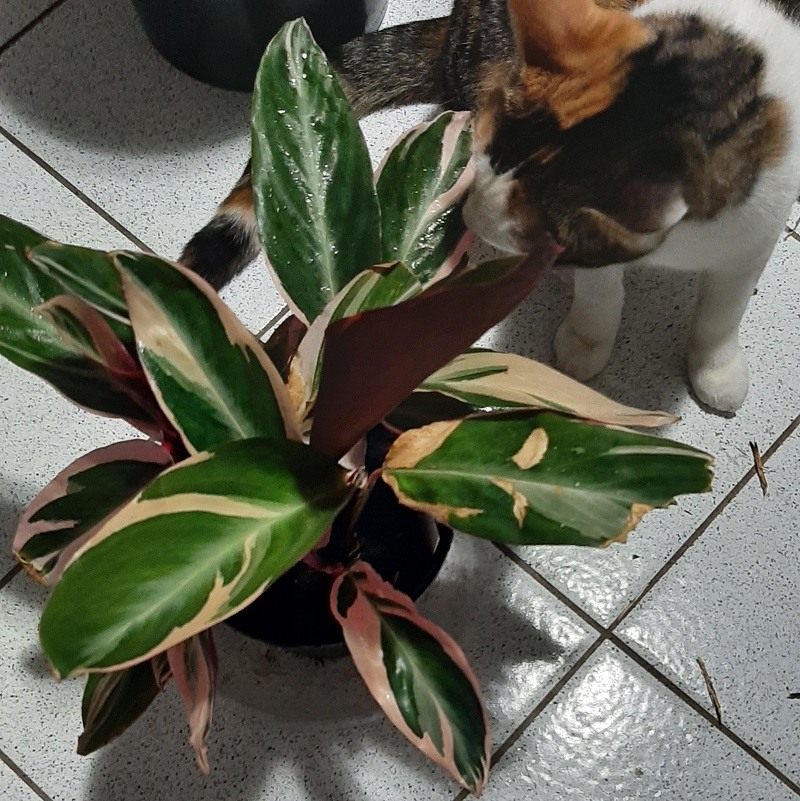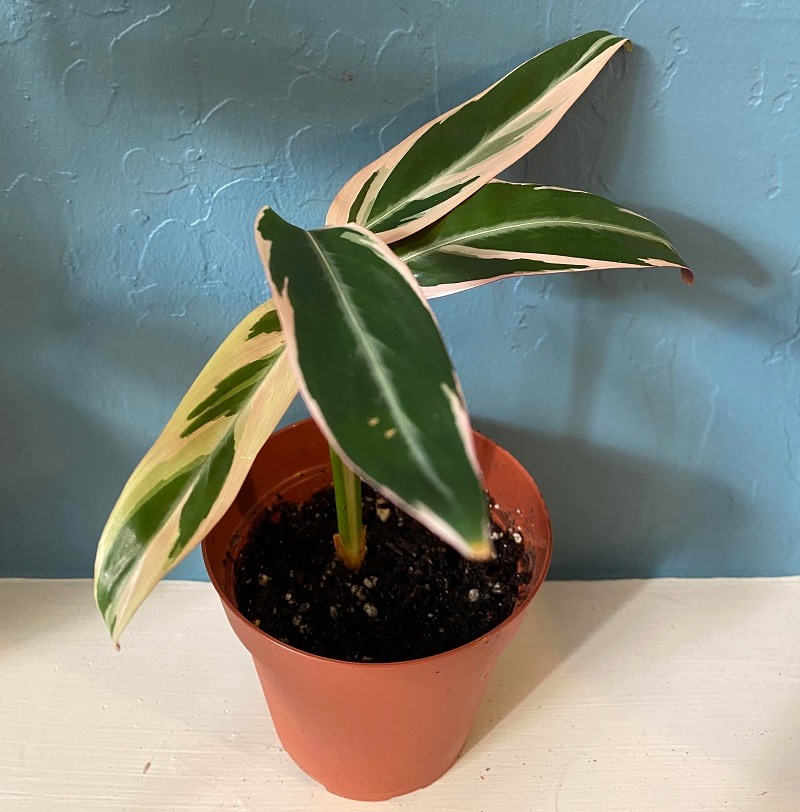Stromanthe triostar is the most colorful and vibrant member of the prayer plant family due to its beautiful foliages with shades of green, white, and pink with bright burgundy undersides. But this finicky diva can be intimidating to grow and maintain.
Stromanthe triostar care regime involves the provision of fertile and well-draining potting mix. Provide medium indirect sunlight, high humidity of at least 50%, and a temperature range of 65-80oF (18-27oC). Feed the houseplant every month during spring season.
Triostar stromanthe is not a suitable houseplant for those season growers with perfection goals due to its demand. But the information in this guide provides comprehensive stromanthe triostar care tips that meet the plant requirements.
You May Also Enjoy: How to Care for Silver Satin Pothos

What Does Stromanthe Triostar Looks Like?
The triostar stromanthe (stromanthe sanguine) has impressive variegated foliages with vibrant shades of pink. The houseplant folds its leaves at night and opens in the morning.
The triostar bears unimpressive spring flowers. But the contrasting foliages are the reason behind its popularity in many households across the country.
Triostar stromanthe is a moderate to a fast-growing and temperamental houseplant. The growth rate can slow down with minimal disturbance making it unsuitable for beginners.
An indoor triostar can reach 2-3ft with appropriate growing conditions. This tropical perennial is native to the jungle of Brazil and loves a high humidity environment.
The foliage colorations and growth habits are similar to never never plant. But the bright burgundy undersides of leaves tend to set these houseplants apart.
Triostar stromanthe is non-toxic to pets and humans. I recommend keeping the houseplant away from cats, dogs, and children to avoid destruction.
Stromanthe Triostar Care Details
| Origin | South America (Jungle of Brazil) |
| Scientific Name | Stromanthe sanguinea triostar |
| Common Names | Stromanthe triostar Calathea triostar Variegated bloody stromanthe |
| Maximum Growth (Approx.) | 2-3ft tall |
| Light Requirements | Medium indirect sunlight |
| Watering Needs | Consistent moist soil that never gets soggy. Use distilled water or rainwater. |
| Soil Requirements | Fertile and well-draining soil. Combine equal parts of potting soil and perlite. |
| Temperature Range | 65-80oF (18-27oC) |
| Fertilizer Application | Every 2-3 weeks during spring and summer. Use a dilute balanced fertilizer. |
| Humidity Needs | The high humidity of at least 50% to keep the foliages happy and healthy. |
| Pruning Requirements | Remove dead leaves to control size and shape |
| Propagation | Division during early spring or summer |
| Re-potting | Do not re-pot the triostar due to its temperamental traits. |
| Pests and Diseases | Pests: Aphids and spider mites Diseases: Fungal diseases due to high humidity and poor ventilation. |
| Toxicity | Non-toxic to pets and humans |
How to Care for Stromanthe Triostar
Stromanthe Triostar Soil Requirements
Triostar stromanthe plants do best in a well-draining, fertile, breathable, and light soil. The potting soil should also hold a relative amount of moisture.
I recommend mixing commercial potting soil with enough perlite for drainage purposes. Add organic matter to improve the potting mix fertility.
Use a shallow planter with adequate space to accommodate the tuberous rhizomes. Ensure the bowl has drainage holes at the bottom to drain excess water.
Light Requirement for Stromanthe Triostar
Most tropical plants thrive under the rainforest canopies. These plants receive indirect sunlight to undertake their physiological activities.
Calathea triostar does best under medium indirect sunlight. Every houseplant enthusiast should replicate the lighting condition at home.
Direct exposure to sunlight will burn and scorch the beautiful foliages. Besides that, the excess sunlight might cause discoloration in the long run.
Place the calathea triostar in a room that receives medium-light to maintain the foliage colors and enhance better growth. Avoid light conditions since it can also cause fading and leggy growth.
Stromanthe Triostar Watering Needs
Most tropical plants have similar water requirements. Triostar thrives in soil with consistent moisture content that never gets soggy.
Too much moisture due to overwatering will result in root rot. Inconsistent watering habits will result in leaf drooping and curling.
Inspect the soil moisture content before watering the stromanthe triostar plant. Insert the index finger in 2-3 inches of topsoil and soak it if it’s dry.
Use distilled water or rainwater to soak the dry potting soil. It will help to rehydrate the plant and avoid inappropriate watering routine problems.
Triostar uses more water during spring and summer due to active growth experience. Reduce the watering frequency during winter as the houseplant enters the dormancy stage.
Stromanthe Triostar Humidity Requirements
Calathea triostar plants hail from the Brazilian rainforest in a warm and humid environment. It is the responsibility of season growers to replicate the growing conditions at home.
Ensure the indoor humidity level is at least 50% to keep the houseplant happy and healthy. Use a digital hygrometer to help in detecting indoor humidity fluctuations.
Install an electric humidifier to boost the indoor humidity and meet the houseplant requirements. Ensure the indoor space is well-ventilated to discourage pest and fungal diseases.
Low indoor humidity will make the brown triostar leaf tips and edges. Another excellent option to increase humidity is to group the plant with other houseplants.
Indoor Stromanthe Triosar Temperature Requirements
Indoor temperature is susceptible to fluctuations due to weather changes. Growing and caring for stromanthe triostar indoors will pose a challenge.
Triostar plants do best under a temperature range of 65-80oF (18-27oC). Keep the indoor plant away from cold and hot drafts to enhance healthy growth.
Stromanthe Triostar Fertilizer Applications
Calathea triostar is a light-feeder tropical houseplant. But the application of fertilizer during spring and summer will help foster vegetative growth.
Use a dilute and well-balanced fertilizer to feed the houseplant every 2-3 weeks. Ensure the fertilizer formula has limited nitrogen compounds.
Too much fertilizer application will cause brown stromanthe triostar leaves. Remember to flush the potting soil every three months to avoid salt buildup around the roots.
Stromanthe Triostar Pruning Requirements
Stromanthe triostar plants have a minimal to no pruning requirement routine. I recommend trimming the old or damaged leaves with a sterilized hand pruner.
Pruning helps control the size and shape of the houseplant. It would be best to trim the triostar during springtime or early summer.
Stromanthe Triostar Propagation
Division of the rhizome clump is the best method for propagating stromanthe triostar. The task should be carried out during early springtime.
Be gentle on the roots since the houseplant is sensitive to disturbances. Ensure each section of the rhizome has a set of roots before planting in a new container.
Cover each rhizome section in a separate container with recommended potting mix. Water and set it in a region with adequate light.
How to Repot Stromanthe Triostar
Stromanthe triostar is less vulnerable to root-bound issues due to a slow growth rate. The best time to transplant the triostar is during spring and summer.
Use a shallow planter when re-potting the houseplant. Use a slightly larger pot and well-draining potting mix. Cover the rhizome with the potting mix and soak it with distilled water.
Stromanthe Triostar Problems and Solutions
Pests
Stromanthe triostars can attract aphids and spider mites. Insect infestation is due to low humidity and poor ventilation. Use mild horticultural soap sprays to eradicate these sap-sucking creatures.
Diseases
Triostars are vulnerable to fungal and mold growth due to overwatering. Besides that, excess moisture can result in root rot. Re-pot the houseplant to revive it back.
Frequently Asked Questions
Is Stromanthe Triostar Toxic?
Stromanthes are non-poisonous to cats, dogs, and humans. But I recommend keeping the houseplant away from kids and pets to avoid destruction.
Why Are My Stromanthe Triostar Leaves Curing?
Under-watering and pest infestations are the leading cause of stromanthe triostar leaves curling. I recommend investigating the houseplant to identify the exact cause and fix it.
Why Does My Stromanthe Triostar Have Brown Tips?
Low humidity and over-fertilization are the possible cause of brown leaf tips among stromanthe triostars. Other possible causes are mineralized water and extreme temperatures.
Why Does My Stromanthe Triostar Have Yellow Leaves?
Overwatering, transplant shock, and the natural aging process are the potential cause of stromanthe triostar leaves turning yellow. Investigate the plant to identify the exact cause and fix it.
You May Also Like: How to Care for Oyster Plant

Final Thoughts
Learning how to care for a stromanthe triostar is a vital routine among both season growers and novice houseplant enthusiasts. It will help foster vibrant and colorful foliage development.
I wrote this stromanthe triostar care guide from my personal experience. I intend to help those individuals looking to add stromanthe triostar to their houseplant collection.
I hope these triostar stromanthe care tips were useful. Use the comment section to share your personal experience and questions regarding this finicky tropical plant.
